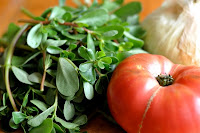 IT’S EASY TO get worked up over all the possibilities for smoked salmon.
IT’S EASY TO get worked up over all the possibilities for smoked salmon.
My advice? Stick to basics. A simple dry brine of brown sugar, salt, pepper, and garlic is really all you need,
4 cups dark brown sugar
1 cup pickling salt
1 head garlic cloves peeled & chopped
black pepper to taste
1. Mix the dry brine ingredients.
2. Generously cover each piece of salmon, then place skin-up in a non-reactive dish. Refrigerate overnight. The brine will become a soupy mess by morning.
3. Gently rinse off each piece and allow to air-dry on paper towels for two to four hours until a pellicle forms—the tacky (not wet) outer layer of flesh that is so loaded with flavor and helps seal in moisture when the fish is smoking.
 4. For the actual smoking I use a Weber “Bullet,” but it’s possible to employ a regular gas grill in a pinch. A water pan is essential for keeping the fish from drying out. For wood chips I like to use fruit trees: apple or cherry. Alder is good too. If not green, the chips need to be immersed in a bucket of water for 30 minutes, then tossed on the coals in handfuls throughout the smoking process. Everyone has their own theories about temperature and smoking duration. Hot smoking will always be quicker than cold smoking. I try to keep the smoker below 250 degrees, and for smaller species like silvers and pinks this means about an hour and a half of smoking.
4. For the actual smoking I use a Weber “Bullet,” but it’s possible to employ a regular gas grill in a pinch. A water pan is essential for keeping the fish from drying out. For wood chips I like to use fruit trees: apple or cherry. Alder is good too. If not green, the chips need to be immersed in a bucket of water for 30 minutes, then tossed on the coals in handfuls throughout the smoking process. Everyone has their own theories about temperature and smoking duration. Hot smoking will always be quicker than cold smoking. I try to keep the smoker below 250 degrees, and for smaller species like silvers and pinks this means about an hour and a half of smoking.
5. The last step is vacuum-sealing. I’ve kept properly packaged smoked salmon in the freezer for two years without any appreciable loss of flavor or tenderness.
Blackberry Must & Citrus Cured Salmon
 Another option is cured salmon. While making blackberry wine I saved the leftover must to cure fresh salmon.
Another option is cured salmon. While making blackberry wine I saved the leftover must to cure fresh salmon.
2 lb salmon fillet(s)
3/4 cup pickling salt
1 cup brown sugar
1 each zest of a lemon, lime & orange
1 teaspoon peppercorns
1 sprig thyme
1 bay leaf
1 cup blackberry must*
* If you happen to have some blackberry must laying around, by all means use it. If not, the rest of the ingredients make an excellent cure on their own.
Mix all ingredients minus the must in a food processor. Next add the must a little at a time, enough to color the cure but not so much as to make it soggy. Spread a thick layer of cure on bottom of non-reactive dish, up to 1/4 inch. Lay salmon, skin side up, on top of cure, then pack remaining cure on top of the salmon. Cover salmon with plastic wrap and weight down with a few pounds (e.g., cans from the cupboard). Flip salmon in 12 hours. Salmon is finished after 24 hours. Rinse and dry.
The cured salmon will be darker, with an attractive, slightly purple hue from the must, plus there will be a smattering of blackberry seeds that give it extra texture. Slice thinly off the top and eat within a week. I had mine on pumpernickel with a dollop of creme fraiche and chives.
Like this:
Like Loading...
 I had the pleasure of sitting down recently with Eric Parkinson, of This Must Be the Place, a podcast that seeks to reveal “the unique physical, cultural, and emotional layers of places.”
I had the pleasure of sitting down recently with Eric Parkinson, of This Must Be the Place, a podcast that seeks to reveal “the unique physical, cultural, and emotional layers of places.”




























